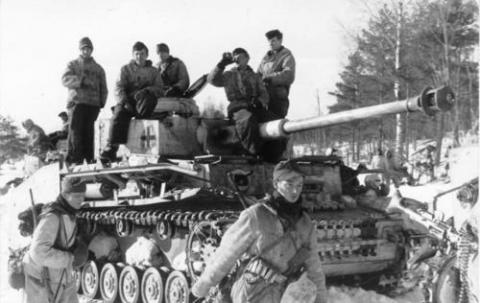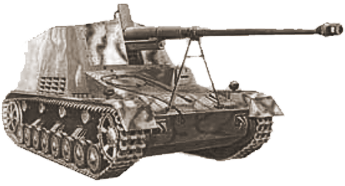The Red Army vs. Army Group North - Early 1943

When discussing the January 1943 fighting between Germany and the Soviet Union the overwhelming majority of today's literature focuses on events at Stalingrad. In doing so, a major disservice is done to history, for in the first three months of 1943 the Red Army attempted to crush the German Sixteenth Army and Army Group North much as it had eliminated the German Sixth Army and attempted to destroy the German Army Groups in Southern Russia.
In Northwestern Russia the nearly one and one half year long German siege of Leningrad had precipitated yet another Russian relief attempt when the Second Battle of Lake Ladoga opened on January 12, 1943. In this offensive, the Red Army launched a massive assault by the Leningrad, Northwestern and Volkhov Fronts, preceded by a nearly two and a half hour 4,500 gun bombardment was followed by relentless attacks from the reconstituted, for the third time, 2nd Soviet Shock Army, and the 67th Army. The fighting was fierce everywhere the Red Army struck the German positions, in particular, the combat along the frozen Neva River reached a feverish pitch as the outnumbered German infantry, heavily armed with automatic weapons, fought off the advancing Soviet rifle divisions. The German infantry in Army Group North, used to fighting with hardly any armored support, did possess in January 1943 one of the few independent Tiger battalions, the 502nd Heavy Tank Battalion, and this single tank battalion was put to good use in limiting the Red Army's gains. Nonetheless, the Red Army broke the siege of Leningrad and opened a 6-mile wide land corridor to the embattled city. This success resulted in Stavka's decision to try and crush the bulk of German Army Group North in a campaign codenamed Operation Polar Star.
In Polar Star Stavka sought to forge an immense deep operational penetration of the German Sixteenth Army's positions far south of Leningrad, in the Demiansk region. This penetration would include a thrust to the Baltic by a special operational group featuring a full Tank Army. This massive campaign involved the Leningrad, Volkhov and Northwestern Fronts commanded by Govorov, Meretskov and Timoshenko respectively. Whereas Vasilevsky and Zhukov had been heavily involved together in planning the Soviet operations further south, Polar Star was run by Zhukov. All through January and February Stavka sent a steady stream of reinforcements in particular to Timoshenko's Northwestern Front. Foremost in these reinforcements was the Special Group of Forces Khozin, led by Colonel General M.S. Khozin and featuring the 1st Tank Army, led by Lieutenant General M.E. Katukov and 68th Army, led by Lieutenant General F.I. Tolbukhin. Beginning on February 10th the three Fronts involved would launch a series of four offensives as part of Operation Polar Star with the Northwestern Front the primary striking force involved in the operations.
Polar Star had goals every bit as ambitious as Uranus had in November of 1942 and was also as ambitious as anything else launched by the Red Army in February-March 1943. For example, Polar Star featured three Soviet Fronts seeking to penetrate as far as 110 miles behind Army Group North's lines with the German army group's destruction as its final goal. These objectives were entirely comparable to what the Red Army had sought to do on the Central and Southern part of the German Eastern Front during the winter of 1942-43.
Ultimately, by March of 1943 Polar Star had failed to achieve its goals. This failure stemmed from a number of reasons. First, the continuous December 1942-March 1943 fighting that marked the Red Army's repeated assaults on Army Group North had left the Leningrad and Volkhov Fronts far too weakened to achieve Polar Star's goals. Second, Hitler had allowed his armies to reposition prior to the anticipated Soviet offensive and as a result, the Red Army was forced to restructure its efforts. It would pay dearly once an abbreviated version of Polar Star re-opened in March. Third, by March of 1943 the Northwestern Front was a mere shadow of its former self and would only grow weaker as German counteroffensives in Southern Russia forced Stakva to send south the 1st Tank Army, 9th Tank Corps, 1st Mechanized Corps and over three dozen divisions. From March 9th-11th alone The 1st Tank Army, both the Mechanized and Tank Corps, plus over one dozen divisions had been pulled from the Northwestern Front in response to Manstein's savaging of the Southwestern and Voronezh Fronts. The Northwestern Front would only experience greater losses as Manstein completed his recapture of Kharkov and Belgorod.
Overall, in three months fighting near Leningrad the Red Army lost 270,000 dead and wounded for negligible gains in real estate. To the south of Leningrad the fighting for the Demiansk salient that had begun in January 1942 had been even more draining. There, the Northwestern Front lost 682,282 men, including 220,713 permanent losses in combat around the salient that had dragged on from the Red Army's January 1942 offensive all the way up to March 1943. On the other hand, the Red Army had achieved quite a bit in finally breaking the German siege of Leningrad in part if not in full. In addition, the three Soviet Fronts in the region had tied down 30 German divisions that could have been better used elsewhere on the front. Finally, the Red Army had so weakened Army Group North and alleviated enough of the immediate danger facing Leningrad to such an extent that the Northwestern Front was able to give up four armies to support Soviet efforts near Kursk during the ensuing summer and fall.
by Steven Douglas Mercatante



Post new comment